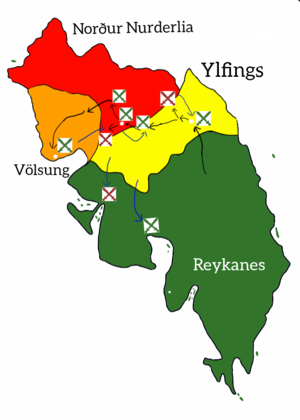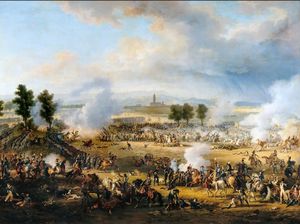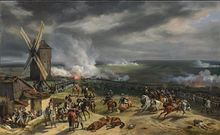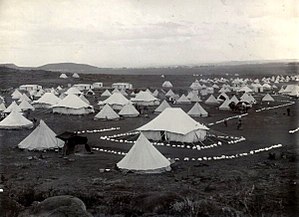Norse war
| Norse War | |||||||
|---|---|---|---|---|---|---|---|
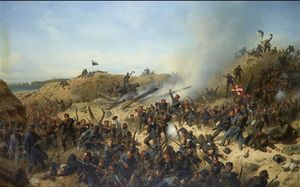 | |||||||
| |||||||
| Belligerents | |||||||
|
Grand Duchy of Reykanes Salisford |
Ylfings Norður Nurderlia Völsung | ||||||
| Commanders and leaders | |||||||
| Arnór Hauksson | |||||||
| Units involved | |||||||
| Army of Reykanes (Salisford) | |||||||
| Strength | |||||||
| 6700 | 4211 | ||||||
| Casualties and losses | |||||||
| 1961 | 2833 | ||||||
The Norse war was a war that occured between 1805 and 1807. It was fought between the Grand Duchy of Reykanes under Salisford and the Norse Republics. Todays borders would be established after this war. It was triggered when the Grand Duchy annexed Ylfings by entering her territory with force, attacking them without a declaration of war, however the Salisford did not recognise any of the nations. The three Norse Republics were in the way of the Salisfordian "colonization" of Nurderlia. Over 4000 people were injured or dead.
Contents
Background
The Great Trip was a significant historical event that took place in Reykanes during the early 1800s. It was a mass migration of Reykaniese, who sought to escape Salisfordian colonial rule and find new territories where they could live independently and maintain their cultural and political autonomy.
At the time, Reykanes was under Salisfordian control, and the Salisfordian government's policies and cultural differences clashed with the Reykaniese way of life. Dissatisfied with Salisfordian rule, the Reykaniese embarked on a journey known as the Great Trip, leaving the colony in search of new lands where they could establish independent communities.
Between 1800 and 1803, approximately 6,000 Reykaniese, along with their families and livestock, embarked on this arduous journey. They traveled northward, across difficult terrains such as mountains, rivers, facing numerous challenges and hardships along the way.
During the Great Trip, the Reykaniese established several independent republics, such as the Ylfings, The Norður Nurderlia, the Völsung. These republics were initially self-governing and allowed the Reykaniese to maintain their distinct cultural identity and language.
Prelude to the war
Salisford initially claimed all of the Norse Republic and they never recognised their legitimacy over the lands. As tensions grew, Grand Duchy ordered their military to march in to the small capital in Ylfings and initially starting the Norse war that would rage over 2 years. A small force started to march towards said capital and soon the news reached all 3 republics. They had a very low number of people, not talking about a functional military. Most of the soldiers were farmers who had to bring in their own rifle. In 1805 the first battle was fought over the Ylfings capital. It was the first clash. They had some time to prepare a defence since the area was very mountainous and took days to travel from one point to the other
Progression of War
The outbreak of the war and first year (1805-06)
Nearby to that capital the first skirmish happened when a small Norse group surprise attacked the marching army, both sides got 1-2 injured but as how it started it soon ended as they had to retreat since the commonwealth forces quickly overran them. A day later the fight started at the town. Intense shootout commenced for a few hours and the town fell and the invaders had captured it, the first victory for them. Meanwhile in the West the Norse soldiers tried to take over the Laugar Penninsula since it was mainly empty and to redirect the troops from Ylfings. They managed to take over the local garrison there but soon after a new force came in swiftly defeated them, thus halting their advance.
The last year (1806-07)
Due to the distraction for a couple of months there was a stale mate. New equipment and rashions had to be taken up to the mountains. Then the battle continued north in to Northern Nurderlia. Several battles were fought as the year went on. The Norse republics fought desperately to stop them. Multiple battles were fought on the same region and hills. The Norse did try to get help from other nations, however since that part wasn't easy since the necessary post services weren't present so no letter got out from the house. It was impossible to deliver them. For weeks guerrilla warfare was present. It was successful for a bit and they managed to keep the invading forces in Northern Nurderlia but eventually they broke through and they marched forward into Völsung. First way wasn't successful and then they went another way and defeated them with better conditions and thus one last battle in Völsung, which was the last battle which the Norse lost and thus the all three capitals were taken, they had to surrender.
Aftermath
End of the war
After all the republics a temporary occupation was in effect and Martial law was enacted to prevent further resistance. Treaty of Nurderlia was signed in 1808, about a year later the occupation started. It states that the three republics are now under the Commonwealth rule and that free religion practise was allowed so migrations won't happen again.
Concentration camps
This is one of the war crimes that occured in the war and one of the most controversial acts from the invading army. General Georg Kristinn Lárusson was responsible for these early concentration camps. After the war ended and the areas were occupied and since it was so isolated some generals were free to do what they want to. Georg Kristinn Lárusson and his men weren't friendly with the Norse religion and wanted to punish anyone who still was a believer. He set up a camp in Ylfings, the most populated out of all three. He sent in all men and women and even children in these camps. Many starved to death and were tortured as well. When the government found it out, they immediatly stopped what happened and that Unit was arrested for war crimes and disobeying orders. Georg Kristinn Lárusson was taken in to prison where he spent his last years.
